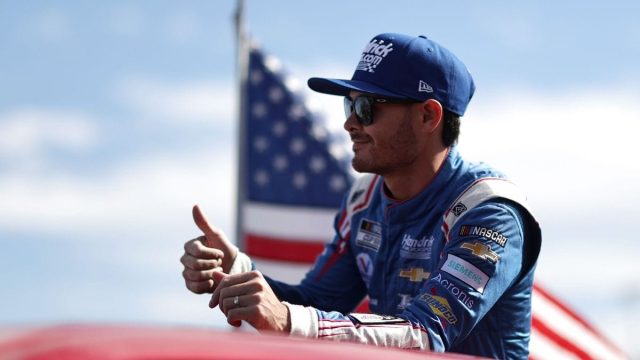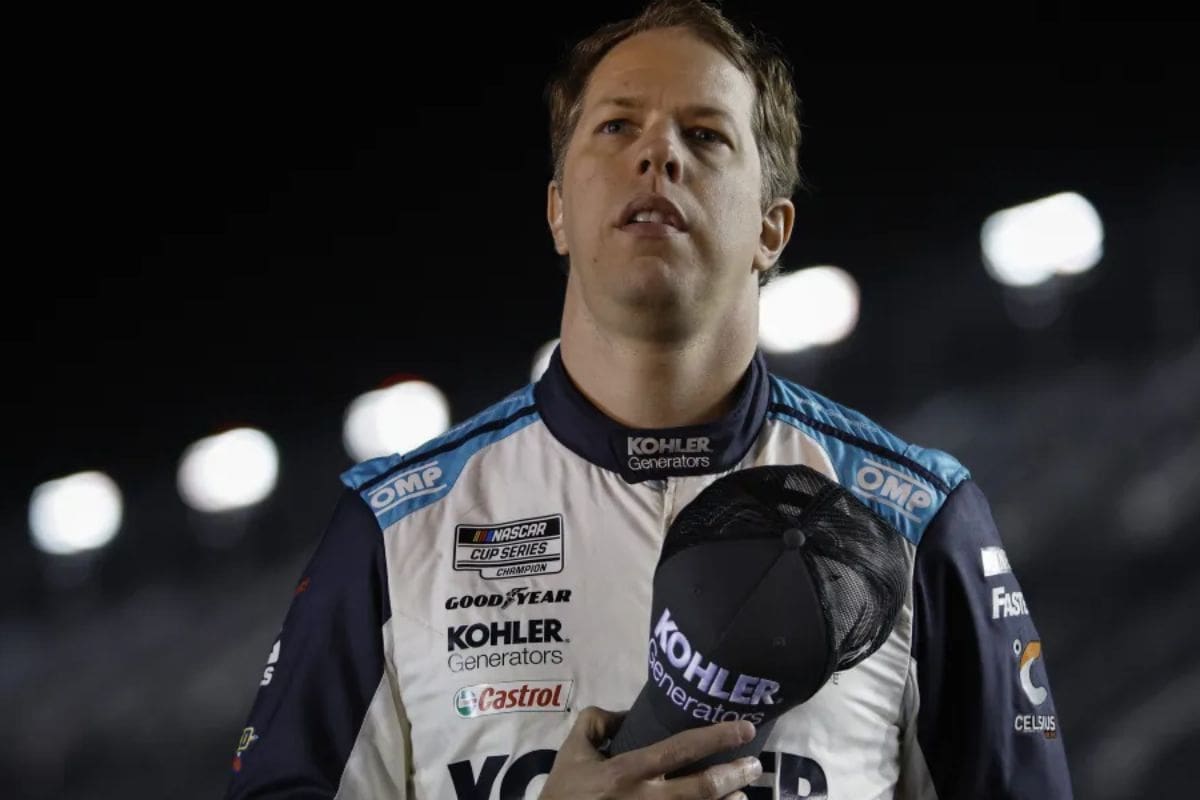Kyle Larson and Ryan Blaney’s Dispute Post Brickyard 400: Kyle Larson emerged victorious at the Brickyard 400, but his win wasn’t without controversy. Following a vital restart incident that favored Larson, Ryan Blaney criticized him, branding him a ‘golden boy.’ This remark emphasizes the ongoing tensions within the NASCAR community regarding perceived favoritism and the rules of racing. The outcome was greatly influenced by Brad Keselowski’s gamble on fuel strategy, which ultimately paved the way for Larson’s success. Using social media, Larson responded to Blaney’s comments, further intensifying the rivalry.
Key Highlights
- Kyle Larson responded to Ryan Blaney’s ‘golden boy’ remark on social media after winning the Brickyard 400, emphasizing his racing skills.
- Blaney’s comments highlighted frustration over perceived favoritism in NASCAR, reflecting ongoing rivalries and tensions among drivers.
- The victory came after a controversial restart incident, which Larson navigated strategically, showcasing his adaptability under pressure.
- Larson’s win, concluded under caution, raised debates about race legitimacy and the impact of race decisions on driver perceptions.
Kyle Larson Wins at Brickyard 400
Capitalizing on a series of unexpected events during the final stage, Kyle Larson secured a remarkable victory at the Brickyard 400, showing his strategic skill and racing insight in a fiercely competitive field. Larson’s ability to handle the unpredictable dynamics of the race showed his deep understanding of his vehicle and the subtleties of the Indianapolis Motor Speedway.
Throughout the event, Larson displayed impressive adaptability, adjusting his strategy to respond to the shifting circumstances on the track. The combination of his keen observational skills and proactive decision-making allowed him to capitalize on opportunities that emerged as the race progressed. This adaptability proved vital, as he skillfully drove through traffic and took advantage of competitors’ missteps, thereby positioning himself for an ideal finish.
Moreover, Larson’s performance can be attributed to his thorough preparation and experience, which enabled him to maintain composure under stress. His ability to remain focused, even in the face of adversity, set him apart from his rivals during critical moments of the race. As the laps wound down, Larson’s resilience and tactical skill became increasingly evident, emphasizing the importance of mental fortitude in achieving success at such a prestigious event.
Controversial Restart Incident at Indianapolis
The recent restart incident during the Brickyard 400 has ignited a heated debate among fans and competitors, particularly following Ryan Blaney‘s criticism of Kyle Larson‘s tactics. The incident occurred after a caution brought on by Kyle Busch’s contact with Denny Hamlin, which ultimately forced the race into overtime. As the green flag waved, Larson capitalized on a crucial moment when Brad Keselowski ran out of fuel, sparking Blaney’s vehement backlash.
Blaney’s choice of words—referring to Larson as NASCAR’s “golden boy”—reflects a deeper frustration within the competitive landscape. This sentiment resonates with many drivers who perceive Larson’s opportunistic driving as a violation of the rules of racing. In a sport where tactical positioning and respect among competitors are paramount, Larson’s actions have drawn scrutiny, particularly when they yield notable advantages.
However, this incident is indicative of the larger tensions that exist within NASCAR, where split-second decisions can lead to polarizing outcomes. Larson’s ability to seize the moment during the restart highlights his skill and awareness on the track; yet, it simultaneously invites criticism for what some may interpret as unsportsmanlike behavior.
Brad Keselowski’s Fuel Mishap and Larson’s Opportunity
Keselowski’s risky decision to stretch his fuel reserves during the overtime period set the stage for Larson’s tactical ascent to the lead, highlighting the balance between risk and reward in NASCAR racing. In an environment where strategy often dictates success, Keselowski’s gamble ultimately fell short as he ran out of fuel just as the race was about to commence again. This crucial moment allowed Larson, who was positioned behind him, to capitalize on the unexpected turn of events.
Keselowski was at the bottom of the track, with Blaney in second place on the outside. Larson was in third place inside, behind Keselowski. When Keselowski moved to the pit road to refuel after the race restarted, Larson moved up into his spot and took the lead.
Soon after, a big wreck in the middle of the pack caused the race to go into double overtime. This put Larson in a perfect position to win. This instance shows not only the unpredictability of the sport but also the importance of keen situational awareness among drivers.
Ryan Blaney’s Reaction on Radio
Frustration boiled over for Blaney as he expressed his disbelief over the race’s decision to allow the green flag to wave, feeling that it unfairly handed the victory to Larson while reducing his chances from the top position. The anger radiating from Blaney during the event emphasized the intensity of competition in NASCAR, highlighting the thin line between victory and perceived injustice.
“There’s no way they should’ve let that go green. That’s ridiculous. They just GAVE it to him (Kyle Larson).” – (Blaney)
Kyle Larson’s Response to Ryan Blaney
Kyle Larson’s victory at the Brickyard 400 not only solidified his position in the standings but also prompted a pointed response on social media, showing the complexities of competition and communication in NASCAR. As Larson crossed the finish line ahead of Tyler Reddick, the race concluded under caution, a scenario that often fuels debate regarding the legitimacy of the outcome. Nevertheless, Larson’s ability to drive the final laps effectively displayed his skill and tactical strategy on the track.
In the aftermath of his win, Larson took to Twitter to deliver a subtle yet impactful retort to Ryan Blaney, who had previously referred to him as the ‘Golden Boy.’ This exchange highlights not only the intensity of interpersonal rivalries in the sport but also the increasing role of social media as a platform for drivers to assert their dominance and clarify their positions within the competitive landscape.
😎 thanks @NASCAR 🤝 https://t.co/8ffMfAtgzd
— Kyle Larson (@KyleLarsonRacin) July 22, 2024
News in Brief: Kyle Larson and Ryan Blaney’s Dispute Post Brickyard 400
The aftermath of the Brickyard 400 highlights the intense rivalries and emotional dynamics within NASCAR. Larson’s victory, coupled with Blaney’s critical remarks, emphasizes the competitive atmosphere that fuels fellowship and conflict among drivers.
The incident involving the controversial restart and Keselowski’s tactical fuel gamble further shows the unpredictable nature of racing. Such moments not only shape individual legacies but also influence the broader narrative of the sport, showing the fine line between victory and controversy in competitive racing.
ALSO READ: Rick Hendrick Praises Kyle Larson’s Brickyard Win at the Glorious Indianapolis Speedway



